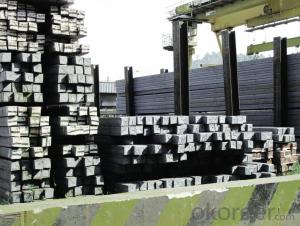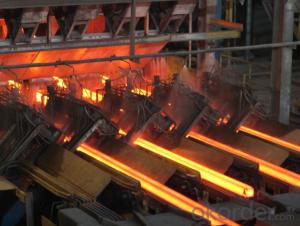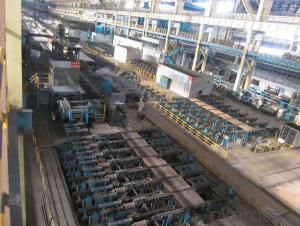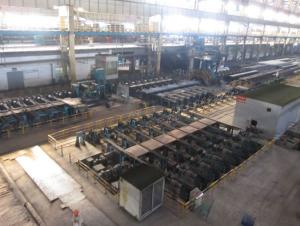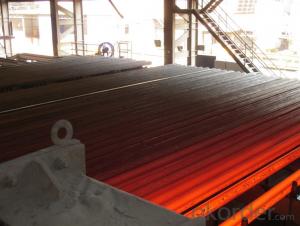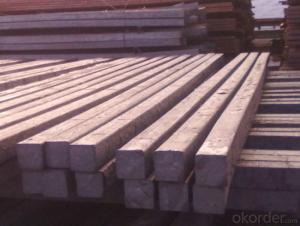Hot Rolled Square Steel Billet 3SP Standard 100mm
- Loading Port:
- Shanghai
- Payment Terms:
- TT OR LC
- Min Order Qty:
- 2000 m.t.
- Supply Capability:
- 10000 m.t./month
OKorder Service Pledge
OKorder Financial Service
You Might Also Like
Structure of Hot Rolled Square Steel Billet 3SP Standard 100mm

Description of Hot Rolled Square Steel Billet 3SP Standard 100mm
PPGI is made by cold rolled steel sheet and galvanized steel sheets as baseplate, through the surface pretreatment (degreasing, cleaning, chemical conversion processing), coated by the method of continuous coatings (roller coating method),
and after roasting and cooling. Zinc coating: Z60, Z80, Z100, Z120, Z180, Z275, G30, G60, G90
Alu-zinc coating: AZ60, AZ80, AZ100, AZ120, AZ180, G30, G60, G90

Main Feature of Hot Rolled Square Steel Billet 3SP Standard 100mm
1) Excellent corrosion resistance: The zinc layer provides a good protection of Pre-painted Galvanizeed Steel Sheet.
2) High heat resistance: The reflective surface of the material aids in efficiently reflecting the sunlight away and in turn reducing the amount of heat transmitted. The thermal reflectivity converts into energy savings.
3) Aesthetics: Pre-Painted Galvanized steel sheet is available in plethora of patterns and multiple sizes as per the requirements that given by our customers.
4) Versatility: can be used in the various areas.Standard seaworthy export packing: 3 layers of packing, inside is kraft paper, water plastic film is in the middle and outside GI steel sheet to be covered by steel strips with lock, with inner coil sleeve.
Applications of Hot Rolled Square Steel Billet 3SP Standard 100mm
1) Automotive bodies: filters, fuel tanks, etc.
2) Construction materials: roofings, welding pipes,
3) Electric and electronic appliances: computer cans, etc.
4) Steel cans: containers, etc.
5) Steel furniture: washing machines, refrigerators, microwaves, etc.
6) Drums
7) Office equipment: printer, recorders, etc.
8) Motors and transformers

Specifications of Hot Rolled Square Steel Billet 3SP Standard 100mm
| Classified symbol | Yield Point Minimum N/mm2 | Tensile Strength Minimum | Elongation Minimum % | Application | ||||
| N/mm2 | Nominal Thickness mm (t) | |||||||
| JIS | Yogic | 0.25-0.4 | 0.4-0.6 | 0.6-1.0 | 1.0-1.6 | |||
| G3312 | specification | |||||||
| CGCC | CGCC | -205 | -270 | -20 | -21 | -24 | -24 | Commercial |
| CGCD | CGCD | --- | 270 | --- | 27 | 31 | 32 | Drawing |
| --- | CG340 | 245 | 340 | 20 | 20 | 20 | 20 | Structural |
| CGC400 | CG400 | 295 | 400 | 16 | 17 | 18 | 18 | Structural |
| CGC440 | CG440 | 335 | 440 | 14 | 15 | 16 | 18 | Structural |
| CGC490 | CG490 | 365 | 490 | 12 | 13 | 14 | 16 | Structural |
| CGC570 | CG570 | 560 | 570 | --- | --- | --- | --- | Structural |
| ASTM Designation | Yield Point Minimum | Tensile Strength Minimum | Elongation Minimum % | Application | Q/BQB 445-2004(China standard) | ASM A653/A653M | JISG 3312 | |
| ksi(MPa) | ksi(MPa) | TDC51D+Z | (CS TYPE A+Z) | CGCC | ||||
| A653(M)-99 CS TYPE A,B,C | --- | --- | --- | Commercial | TDC52D+Z | CGCD | ||
| A653(M)-99 FS | --- | --- | --- | Lock Forming | TS250GD+Z | (G250+Z) | - | |
| A653(M)-99 DS | --- | --- | --- | Drawing | TS300GS+Z | (G300+Z) | CGC 400 | |
| A653(M)-99 SS Grade33(230) | 33(230) | 45(310) | 20 | Structural | TS350GD+Z | (G350+Z) | CGC490 | |
| A653(M)-99 SS Grade37(255) | 37(255) | 52(360) | 18 | Structural | TS550GD+Z | (G550+Z) | CGC570 | |
| A653(M)-99 SS Grade40(275) | 40(275) | 55(380) | 16 | Structural | ||||
| A653(M)-99 SS Grade50(345) | 50(345) | 65(450) | 12 | Structural | ||||
| A653(M)-99 SS Grade80(550) | 80(550) | 82(570) | --- | Structural | ||||
FAQ of Hot Rolled Square Steel Billet 3SP Standard 100mm
We have organized several common questions for our clients,may help you sincerely:
1. How Can I Visit There?
Our company is located in Tianjin City, China, near Beijing. You can fly to Tianjin Airport Directly. All our clients, from home or aboard, are warmly welcome to visit us!
2. How Can I Get Some Sample?
We are honored to offer you sample.
3. Why choose CNBM?
1, ISO, BV, CE, SGS approved.
2, Competitive price and quality.
3, Efficient service team online for 24 hours.
4, Smooth production ability(50000tons/month) .
5, quick delivery and standard exporting package.
6, Flexible payment with T/T, L/C, Paypal, Kunlun bank, etc .
- Q:How are steel billets coated or painted?
- Steel billets can be coated or painted through several methods. One common technique is hot-dip galvanizing, where the billets are immersed in a bath of molten zinc. This process forms a protective zinc coating on the surface of the steel, preventing corrosion. Another method is electroplating, which involves the deposition of a thin layer of metal, such as zinc or nickel, onto the billets using an electric current. Additionally, steel billets can be painted using various coating systems, such as powder coating or liquid paint, to provide a decorative finish or additional protection against rust and environmental factors.
- Q:How are steel billets used in the manufacturing of pumps and compressors?
- Steel billets are an essential raw material in the manufacturing process of pumps and compressors. These billets, which are essentially semi-finished steel forms, are used to create the various components and parts of pumps and compressors. The first step in utilizing steel billets is to heat them to a high temperature in order to make them malleable and ready for shaping. Once heated, the billets are then subjected to different types of metalworking processes such as forging, rolling, or extrusion. These processes help transform the billets into the desired shapes and sizes required for the specific components of pumps and compressors. In the manufacturing of pumps, for example, steel billets are used to create impellers, which are responsible for the movement and circulation of fluids. The billets are shaped into the required impeller design through machining or casting processes. Similarly, for compressors, steel billets are used to create components such as cylinders, pistons, and connecting rods, which are vital for the compression and movement of gases. The choice of steel billets in pump and compressor manufacturing is driven by their desirable properties such as strength, durability, and resistance to corrosion. These properties are crucial for ensuring the longevity and efficiency of these mechanical devices, especially when they are subjected to high pressures, temperatures, and harsh working conditions. Overall, steel billets play a fundamental role in the manufacturing of pumps and compressors as they provide the necessary raw material for shaping and creating the various components that enable these devices to function effectively.
- Q:How are steel billets used in the production of gear blanks?
- Steel billets are used in the production of gear blanks as they serve as the raw material for shaping and forming the gears. The steel billets are heated and forged into the desired shape, and then machined to create the gear blanks. These gear blanks are further processed and finished to become fully functional gears, which are then used in various machinery and equipment.
- Q:How do steel billets contribute to the circular economy?
- Steel billets contribute to the circular economy in several ways. Firstly, they are a key component in the recycling process of steel. Steel is one of the most recycled materials in the world, and the use of steel billets enables the recycling of scrap steel into new products. By using steel billets, the steel industry can reduce the demand for virgin iron ore and the energy-intensive processes associated with its extraction and production. Moreover, steel billets can be produced from various sources, including industrial waste, automotive scrap, and construction waste. This allows for the repurposing of materials that would otherwise end up in landfills, reducing waste and conserving resources. By utilizing steel billets made from recycled materials, the industry can promote a more sustainable and environmentally friendly approach to steel production. Furthermore, steel billets are highly versatile and can be used in a wide range of applications. This versatility extends the lifespan of steel products and reduces the need for replacement. In the circular economy, the aim is to maximize the use of resources, and steel billets contribute to this goal by enabling the production of durable and long-lasting steel products. Lastly, the circular economy emphasizes the importance of closing the loop and ensuring that materials are reused or recycled at the end of their life cycle. Steel billets facilitate this process by being a readily available feedstock for the production of new steel products. This not only reduces the reliance on virgin materials but also minimizes the environmental impact associated with extracting and processing raw materials. In conclusion, steel billets play a crucial role in the circular economy by enabling the recycling of steel, repurposing of waste materials, promoting durability, and closing the loop in the steel production process. Their use contributes to the conservation of resources, reduction of waste, and overall sustainability of the steel industry.
- Q:How do steel billets contribute to the manufacturing of machinery and equipment?
- The role of steel billets in the manufacturing of machinery and equipment is crucial. These semi-finished steel products serve as raw materials in various manufacturing processes. A primary contribution of steel billets to machinery and equipment manufacturing lies in the production of steel bars and rods. These shapes, essential components in the construction of machinery and equipment, are created by heating and then rolling or forging steel billets. Steel bars and rods provide strength, durability, and stability to machine structures. Additionally, steel billets are utilized in the production of other steel components such as gears, crankshafts, and axles. These components are vital for the proper functioning of machinery and equipment, requiring the high strength and toughness offered by steel billets. Manufacturers can rely on steel billets to ensure their machinery and equipment can withstand heavy loads, vibrations, and other demanding conditions. Furthermore, steel billets are commonly employed in the production of steel pipes and tubes, which find widespread use across various industries. These pipes and tubes are essential for transporting fluids, gases, and other materials within machinery and equipment. By utilizing steel billets, manufacturers can create pipes and tubes that not only possess strength and durability but also resist corrosion and wear. Moreover, steel billets contribute to machinery and equipment manufacturing by enabling the production of precision-engineered components. Manufacturers can machine, drill, and shape these billets to meet the specific requirements of different machinery and equipment. This flexibility allows manufacturers to produce intricate and complex components necessary for the efficient operation of machines. Overall, steel billets are integral to the machinery and equipment manufacturing process. They provide the necessary strength, durability, and versatility required to produce components capable of withstanding the demanding conditions of industrial applications. Without steel billets, the manufacturing industry would face difficulties in producing reliable, efficient, and long-lasting machinery and equipment.
- Q:How are steel billets inspected for surface cleanliness?
- Steel billets are inspected for surface cleanliness through visual inspection, where trained inspectors carefully examine the billets for any visible dirt, oxide scale, or other contaminants. Additionally, surface cleanliness can also be tested using methods like magnetic particle testing or ultrasonic testing to detect any hidden defects or impurities.
- Q:What is the role of steel billets in the manufacturing of hydraulic systems?
- Steel billets play a crucial role in the manufacturing of hydraulic systems. They serve as the raw material that is used to create various components and structures within these systems. Hydraulic systems rely on the use of pressurized fluid to transmit power and control mechanical motion. Therefore, the components within these systems need to be strong, durable, and resistant to corrosion and pressure. Steel billets provide the ideal starting material for manufacturing hydraulic system components due to their exceptional strength and toughness. They are typically made from carbon steel, which offers excellent mechanical properties such as high tensile strength and hardness. These properties ensure that the components can withstand the high pressures and forces experienced within hydraulic systems without deforming or failing. Furthermore, steel billets undergo various manufacturing processes such as forging, machining, and heat treatment to shape them into the desired components. These processes allow for the creation of intricate designs and precise dimensions, ensuring a proper fit and functionality within the hydraulic system. Moreover, steel billets are known for their excellent resistance to corrosion, which is crucial in hydraulic systems due to the presence of fluids and potential exposure to moisture. Corrosion can lead to component failure, leaks, and decreased system performance. The use of steel billets helps prevent such issues, ensuring the longevity and reliability of the hydraulic system. In summary, steel billets are essential in the manufacturing of hydraulic systems as they provide the necessary strength, durability, and corrosion resistance required for the components within these systems. Their versatility and ability to be shaped and processed make them an ideal material choice for creating reliable and efficient hydraulic systems.
- Q:How do steel billets contribute to the overall recyclability of a structure?
- Steel billets contribute to the overall recyclability of a structure because they can be easily melted down and reused in the production of new steel products. This reduces the need for raw materials and energy consumption, making the structure more environmentally sustainable. Additionally, the recycling process for steel billets is cost-effective, making it a viable option for manufacturers and builders.
- Q:How are steel billets used in the production of bearings?
- Steel billets are first heated and then forged or rolled into the desired shape and size for bearing production. These billets serve as the raw material for manufacturing bearing components such as inner and outer rings, cages, and rolling elements. The billets are carefully processed and machined to meet the specific requirements of the bearing design, ensuring strength, durability, and precision in the final product.
- Q:Are there any alternative materials to steel billets in certain applications?
- Yes, there are several alternative materials to steel billets in certain applications. Some of these alternative materials include: 1. Aluminum: Aluminum is a lightweight and corrosion-resistant material that is commonly used as an alternative to steel in applications where weight reduction is important, such as in the aerospace industry. 2. Copper: Copper is a ductile and highly conductive material that is often used in electrical and plumbing applications. It is an alternative to steel billets in applications where high electrical conductivity is required. 3. Titanium: Titanium is a lightweight and high-strength material that is commonly used in applications that require both strength and corrosion resistance, such as in the automotive and aerospace industries. 4. Composite materials: Composite materials, such as carbon fiber reinforced polymers, are increasingly being used as alternatives to steel in applications where weight reduction and high strength are critical, such as in the construction of aircraft and high-performance sports equipment. 5. Plastic: Some applications that do not require high strength or durability can use plastic as an alternative material to steel billets. Plastic is lightweight, cost-effective, and can be easily molded into various shapes. It is important to consider the specific requirements of each application when choosing an alternative material to steel billets, as each material has its own unique properties and limitations.
1. Manufacturer Overview |
|
|---|---|
| Location | |
| Year Established | |
| Annual Output Value | |
| Main Markets | |
| Company Certifications | |
2. Manufacturer Certificates |
|
|---|---|
| a) Certification Name | |
| Range | |
| Reference | |
| Validity Period | |
3. Manufacturer Capability |
|
|---|---|
| a)Trade Capacity | |
| Nearest Port | |
| Export Percentage | |
| No.of Employees in Trade Department | |
| Language Spoken: | |
| b)Factory Information | |
| Factory Size: | |
| No. of Production Lines | |
| Contract Manufacturing | |
| Product Price Range | |
Send your message to us
Hot Rolled Square Steel Billet 3SP Standard 100mm
- Loading Port:
- Shanghai
- Payment Terms:
- TT OR LC
- Min Order Qty:
- 2000 m.t.
- Supply Capability:
- 10000 m.t./month
OKorder Service Pledge
OKorder Financial Service
Similar products
New products
Hot products
Hot Searches
Related keywords
